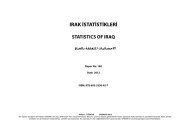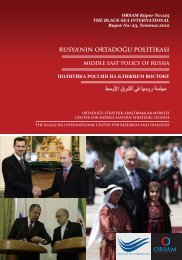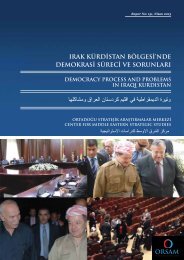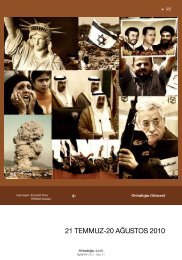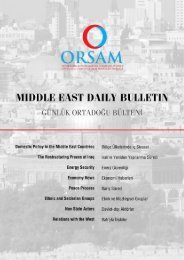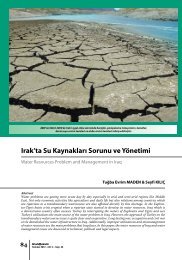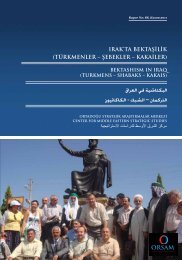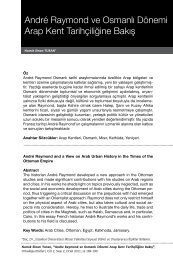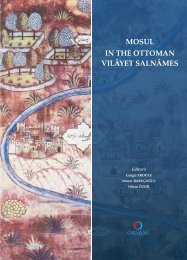turkmen in iraq and their flight - orsam
turkmen in iraq and their flight - orsam
turkmen in iraq and their flight - orsam
You also want an ePaper? Increase the reach of your titles
YUMPU automatically turns print PDFs into web optimized ePapers that Google loves.
TURKMEN IN IRAQ AND THEIR FLIGHT: A DEMOCRAPHIC QUESTION<br />
Jordan (over 700,000) <strong>and</strong> Iran, Egypt <strong>and</strong> Turkey<br />
(about 200,000). This means that the total<br />
number of Iraqi refugees <strong>and</strong> asylum seekers<br />
are over 2.5 million. Towards the end of the<br />
2000s, we saw a little decl<strong>in</strong>e <strong>in</strong> the number of<br />
Iraqi asylum seekers <strong>in</strong> the 44 <strong>in</strong>dustrialised countries<br />
however; Iraq still rema<strong>in</strong>ed the second<br />
pr<strong>in</strong>cipal source country of asylum seekers. 77<br />
Over 95% of the asylum applications reported<br />
<strong>in</strong> Figure 6 were filed <strong>in</strong> Europe. This is significant<br />
because those Iraqi immigrants <strong>in</strong> Europe<br />
<strong>and</strong> other <strong>in</strong>dustrialised countries are less likely<br />
to return to Iraq than immigrants <strong>in</strong> neighbour<strong>in</strong>g<br />
countries. One can assume that the<br />
current total Iraqi immigrant population <strong>in</strong> <strong>in</strong>dustrialised<br />
countries is around a million, <strong>and</strong><br />
that it has a correspond<strong>in</strong>gly large “migration<br />
network.” One should also notice another trend<br />
<strong>in</strong> Figure 6: namely, asylum applications tend<br />
to cont<strong>in</strong>ue <strong>in</strong>creas<strong>in</strong>g many years after crucial<br />
events <strong>in</strong> conflict history. The relatively steep<br />
l<strong>in</strong>es seen after major <strong>in</strong>cidents such as Anfal<br />
(1988-89) <strong>and</strong> the American-led <strong>in</strong>vasion of<br />
Iraq (2003) are <strong>in</strong>dicative of this trend. One could<br />
see similar a correlation with overall migration<br />
flows as well. Crucial event years have<br />
always been the periods dur<strong>in</strong>g which mass refugee<br />
flows were recorded.<br />
Table 3 shows the shifts <strong>in</strong> the rank order of<br />
dest<strong>in</strong>ation countries: Turkey (<strong>and</strong> Greece <strong>in</strong><br />
early periods) attracted Iraqis because of geographical<br />
proximity, but also due to cultural proximity<br />
characterised by the migration of tens of<br />
thous<strong>and</strong>s of Iraqi Turkmen to Turkey dur<strong>in</strong>g<br />
the last two decades). 78 It can also be argued<br />
that Turkey was the easiest dest<strong>in</strong>ation to access<br />
(i.e. long permeable borders), <strong>and</strong> the closest<br />
(i.e. geographical proximity) to reach, for<br />
those Iraqis flee<strong>in</strong>g <strong>their</strong> country <strong>in</strong> the period<br />
immediately follow<strong>in</strong>g the Gulf War, <strong>and</strong> thus<br />
Turkey became the most popular dest<strong>in</strong>ation<br />
between 1991 <strong>and</strong> 1995 for Iraqi migrants. In<br />
the later period, however, Iraqis preferred, <strong>and</strong><br />
<strong>in</strong>deed managed to, migrate to other popular<br />
dest<strong>in</strong>ations. At the end of the 2000s, UNHCR<br />
reported that Germany was the top dest<strong>in</strong>ation<br />
for Iraqi asylum seekers followed by Turkey<br />
<strong>and</strong> Sweden, each received about a quarter of<br />
applications filed <strong>in</strong> the year 2009. 79 Accord<strong>in</strong>g<br />
to the same report <strong>in</strong> the last two years, Iraqis<br />
submitted 64,707 asylum applications <strong>in</strong> the 44<br />
<strong>in</strong>dustrialised countries.<br />
The three major clashes (i.e. war with Iran, the<br />
1991 Gulf War, <strong>and</strong> the 2003 war), <strong>and</strong> cont<strong>in</strong>uous<br />
attacks have shattered Iraq’s economic,<br />
socio-political <strong>and</strong> cultural life s<strong>in</strong>ce 1979 <strong>and</strong><br />
we can see changes <strong>in</strong> asylum applications correspond<strong>in</strong>g<br />
to these periods (table 4 <strong>and</strong> figure<br />
6). Increas<strong>in</strong>g numbers of Iraqi asylum applications<br />
were filed <strong>in</strong> some <strong>in</strong>dustrialised countries<br />
<strong>in</strong> the 1990s, particularly after the Gulf War.<br />
It is important to see the sharp <strong>in</strong>creases <strong>in</strong> the<br />
periods of wars, attacks or violent conflicts <strong>in</strong>clud<strong>in</strong>g<br />
<strong>in</strong>surgencies which <strong>in</strong>creased <strong>in</strong> the second<br />
half of the 2000s.<br />
Of course, asylum seek<strong>in</strong>g, refugees <strong>and</strong> regular<br />
migrant counts <strong>and</strong> statistics are always<br />
short of the accurate figures about migration.<br />
Many Iraqis have opted for irregular migration<br />
because of <strong>in</strong>creas<strong>in</strong>gly tight admission regimes<br />
<strong>and</strong> the very limited opportunities for<br />
regular migration. This was surely the case for<br />
the Turkmen we have <strong>in</strong>terviewed <strong>in</strong> 2004. As<br />
you will see <strong>in</strong> the follow<strong>in</strong>g two chapters, the<br />
majority of Iraqi Turkmen emigrated from Iraq<br />
entered other countries without appropriate<br />
papers (e.g. visas, passports, etc.). Therefore<br />
the usual problems of compil<strong>in</strong>g accurate migration<br />
statistics comes back to haunt us <strong>in</strong> the<br />
Iraqi case.<br />
The Future of International Migration from<br />
Iraq<br />
The overall <strong>in</strong>stability <strong>in</strong> Iraq follow<strong>in</strong>g the<br />
2003 <strong>in</strong>vasion <strong>and</strong> preced<strong>in</strong>g wars, attacks <strong>and</strong><br />
conflicts created an environment prone to a<br />
variety of group conflicts <strong>in</strong> an extremely deprived<br />
socio-economic environment. These are<br />
some aspects of the EOHI <strong>in</strong> Iraq, as discussed<br />
www.<strong>orsam</strong>.org.tr<br />
27




